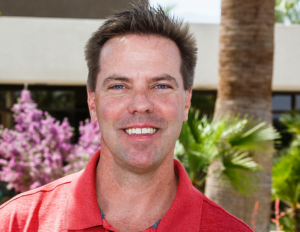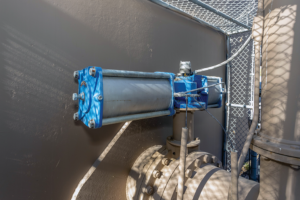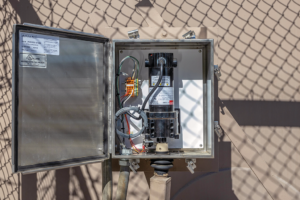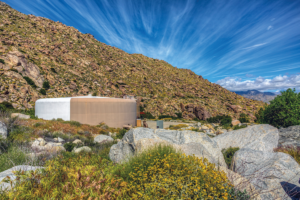D
esert Water Agency (DWA) serves 64,000 people in a service area in California’s Coachella Valley centered on the city of Palm Springs. This area of Southern California is vulnerable to natural disasters of several kinds, primarily earthquakes and wildfires, both of which have occurred in DWA’s service area. As a major utility that provides a life-sustaining resource, DWA has been carefully building its resiliency to natural disasters by modernizing its reservoirs’ earthquake shutoff valves, eliminating fragile pipes, and strengthening its relationships with the local fire department and other agencies.
In this interview, Steve Johnson, DWA’s assistant general manager, speaks with Municipal Water Leader Managing Editor Joshua Dill about how his agency is building up its disaster resilience.
Joshua Dill: Please tell us about your background and how you came to be in your current position.
Steve Johnson: After graduating from California State Polytechnic University, Pomona, in 1993, I  interviewed and was hired by Dames and Moore, a geotechnical engineering firm in Los Angeles. I was a field inspector and worked on several projects, including monitoring subsidence along Hollywood Boulevard during the construction of the red line of the L.A. subway. In 1995, I joined DWA as a staff engineer. Over the past 24 years with the agency, I have worked my way up through the engineering department, and now I am the assistant general manager.
interviewed and was hired by Dames and Moore, a geotechnical engineering firm in Los Angeles. I was a field inspector and worked on several projects, including monitoring subsidence along Hollywood Boulevard during the construction of the red line of the L.A. subway. In 1995, I joined DWA as a staff engineer. Over the past 24 years with the agency, I have worked my way up through the engineering department, and now I am the assistant general manager.
Joshua Dill: Please tell us about DWA.
Steve Johnson: DWA was formed in 1961 and is one of only 29 state water contractors in California. A state water contractor has the authority to purchase water from the State Water Project (SWP). Prior to the formation of DWA, the City of Palm Springs was served by a privately owned water agency, the Palm Springs Water Company. The citizens of Palm Springs realized that the groundwater levels were dropping fast, and to remedy this, they decided to form DWA to purchase SWP water and replenish the valley’s groundwater. In the late 1960s, DWA purchased the Palm Springs Water Company, along with the neighboring Cathedral City Water Company. Today, DWA’s service area covers about 325 square miles. DWA has approximately 23,000 services serving a population of about 64,000 people, most of whom are in Palm Springs. In addition to water management and retail water service, DWA recycles water and conveys wastewater in parts of its service area.
Joshua Dill: What is the source of DWA’s water?
Steve Johnson: DWA sits over the Whitewater, Garnet Hill, and Mission Creek subbasins—parts of the Coachella Valley groundwater basin. I like to describe the valley as a large bowl of sand that captures and holds local mountain runoff and rainfall. The aquifer is estimated to store more than 42 million acre-feet of water in the first 1,000 feet. That groundwater is the major source of our water. The first settlers in the Coachella Valley initially diverted runoff from the surrounding mountains as their water source, but as the population grew they found that the runoff was not enough to sustain their needs and turned to pumping groundwater from wells.
The water that we import is used to recharge and sustain our groundwater. The imported water is delivered  to large ponds and percolates into the ground, where it mixes with the existing groundwater and is eventually pumped and distributed to our customers. Although DWA purchases water from the SWP, the existing conveyance facilities for the SWP are approximately 30 miles west of the Coachella Valley. Another water conveyance system, the Colorado River Aqueduct (CRA), owned and operated by Metropolitan Water District (MWD), runs through our region. DWA and MWD developed and executed an exchange agreement that allows DWA to import water from the CRA into the Coachella Valley in exchange for providing MWD with our allotted SWP water.
to large ponds and percolates into the ground, where it mixes with the existing groundwater and is eventually pumped and distributed to our customers. Although DWA purchases water from the SWP, the existing conveyance facilities for the SWP are approximately 30 miles west of the Coachella Valley. Another water conveyance system, the Colorado River Aqueduct (CRA), owned and operated by Metropolitan Water District (MWD), runs through our region. DWA and MWD developed and executed an exchange agreement that allows DWA to import water from the CRA into the Coachella Valley in exchange for providing MWD with our allotted SWP water.
Joshua Dill: How frequent are earthquakes in your service area?
Steve Johnson: The San Andreas Fault is within 10 miles of Palm Springs, so we are in an active earthquake zone. I would guess that several earthquakes occur every month, but they are not large enough to feel. We have at least one or two earthquakes a year that I would consider moderate in intensity, somewhere between 4.0 and 5.0 on the Richter scale. There have also been some large earthquakes in the Palm Springs region. The 1992 Landers Earthquake, the epicenter of which was just north of Palm Springs, was about a 7.0 on the Richter scale. I was not working at the agency at that time, but I remember the widespread damage that earthquake caused.
Joshua Dill: Would you tell us about some of the infrastructure work DWA is doing to guard against the effects of earthquakes?
Steve Johnson: All our water storage facilities are above-ground welded steel reservoirs, located in the foothills that surround Palm Springs. They were constructed with isolation valves that have pneumatic actuators. It’s an old technology: The actuator contains a small ball that sits on a pedestal, and if there is ground movement of a certain intensity, the ball falls off the pedestal and releases air from the actuator, which then closes the valve. We are in the process of replacing those actuators with more modern, battery-powered devices. The new devices require less maintenance and use advanced ground-movement technology, which is more reliable. They’re quite expensive—the materials alone cost around $30,000 per actuator.
Joshua Dill: Is the idea that, if the pipes in your system are damaged, you don’t want water leaking out?
Steve Johnson: Correct. A large earthquake could damage water mains, causing large leaks that would then drain our reservoirs. We have 59 million gallons of storage. In the case of a major earthquake, we do not expect to have power for our pumps. We want to preserve as much water as we can in our reservoirs and then evaluate our system for damages. After that assessment, we can route our water in strategic ways. The fire department may need water in some areas for fire fighting. We would also have to set up water distribution points for residents. We may want to isolate certain areas where we know there are large main breaks. Preserving the water in our reservoirs is the prerequisite for all that.
Joshua Dill: How are you making your pipelines more resilient?
 Steve Johnson: In the early 1990s, we started using ductile iron pipe. In the 1980s, we used asbestos concrete pipe, which is long lasting but fairly fragile. Ductile iron is more resilient when it comes to earthquakes.
Steve Johnson: In the early 1990s, we started using ductile iron pipe. In the 1980s, we used asbestos concrete pipe, which is long lasting but fairly fragile. Ductile iron is more resilient when it comes to earthquakes.
Joshua Dill: Does DWA have any concerns about major water pipelines or the CRA getting damaged in an earthquake?
Steve Johnson: The agency is extremely concerned about damage to major transmission pipelines. These mains are large in size and, if severed, will not only cause a tremendous amount of flooding but will rapidly draw down our reservoir storage. That is why it is important for us to have the isolation valves on the reservoirs. We store a limited amount of larger-size pipeline at our operation center facility to expedite any needed repairs.
Any damage to the CRA would most likely lead to a halt in imported water deliveries to the valley. Without the imported water, we would be unable to recharge the aquifer until the repairs are complete. Damage to the aqueduct could also result in catastrophic flooding, depending on where the damage occurs.
Joshua Dill: How do you plan for an earthquake? Do you make your plans based on the expectation of an earthquake of a specific intensity?
Steve Johnson: All our planning involves a significant earthquake. There isn’t a specific size, but we expect to see major damage in our area when the big one hits. Based on my experience, something of the magnitude of 7.0 or greater along the section of San Andreas Fault located north of Palm Springs would be a devastating event for the valley.
Joshua Dill: How do wildfires affect DWA?
Steve Johnson: Although we are a desert agency, we do have some facilities located in the foothills that surround Palm Springs that are vulnerable to wildfires, particularly our steel reservoirs. Last year, there was a fast-moving wildfire on the south end of Palm Springs that started about a half mile below two of our 5-million-gallon reservoirs. Because we create a buffer, or shrub-free zone, around our facilities, the fire caused little damage. The fire department was then able to use our site as a staging area and use the water in the reservoirs to fill their trucks. That buffer zone was critical to protecting our reservoirs.
Joshua Dill: What sort of planning can you do to prepare for natural disasters?
Steve Johnson: DWA meets annually with the Forest Department to review procedures for events such as wildfires. We also discuss events that may have occurred over the past year. It’s important for us to have updated contact information on hand so that if something does happen, we can call the right person.
Joshua Dill: Would you tell us about the simulations and training that DWA does with the local fire department?
Steve Johnson: In 2017, DWA staff, along with city emergency response personnel and local Tribe management staff, participated in the city of Palm Springs emergency operations center tabletop exercises. In those exercises, we simulated several scenarios that might happen as a result of a large earthquake. Participants discussed things such as who the primary contact would be and what equipment or supplies would be available to the different parties involved. It was during this exercise that city fire department staff learned that DWA has earthquake shutoff valves that will isolate the reservoirs and that water may not be available for firefighting if the valves are closed. As a result, DWA and the fire department developed a communication plan. DWA staff meet with city emergency response staff annually.
We also collaborate with the city fire department on confined space training exercises. We have several large vaults that allow for rescue training. We usually train annually.
Joshua Dill: What is the best way to predict the possible effects of a major natural disaster on your system, and have you made any changes to your operations based on what you have observed in natural disasters elsewhere?
 Steve Johnson: I am familiar with some of what utilities face in natural disasters based on my experiences at
Steve Johnson: I am familiar with some of what utilities face in natural disasters based on my experiences at
Dames and Moore. In 1994, there was a major earthquake in Northridge, a suburb of Los Angeles. Dames and Moore published a report in its in-house magazine about the damage caused by this earthquake. We used that report to research how a similar disaster would affect DWA facilities. The Northridge earthquake damaged gas mains, creating several fires throughout the city. That reinforced our awareness of the need to ensure that we have water storage and good lines of communication to the fire department. We also learned that the earthquake caused a lot of damage to sewer pipes. Although wastewater conveyance is a small part of our responsibility, we invested in a significant amount of sewer pipe for our inventory. We also realized that we needed to develop a plan to get supplies to us. The Northridge earthquake damaged some freeway overpasses, making it difficult to reach some areas. There is only one main freeway through the Coachella Valley, the I-10. We think there is a high possibility that access to the Los Angeles area would be limited by highway damage in the case of a major earthquake. We have been developing plans to work with suppliers to our east, in Arizona, as alternatives in case of an emergency.
Steve Johnson is the assistant general manager of Desert Water Agency.
He can be contacted at sjohnson@dwa.org.
